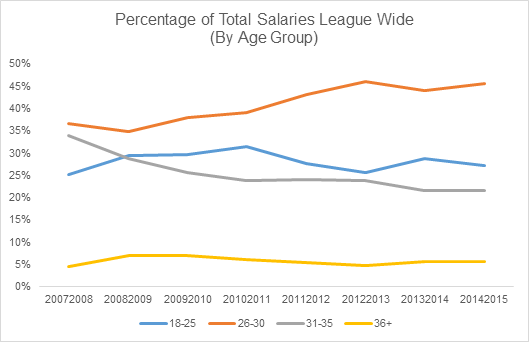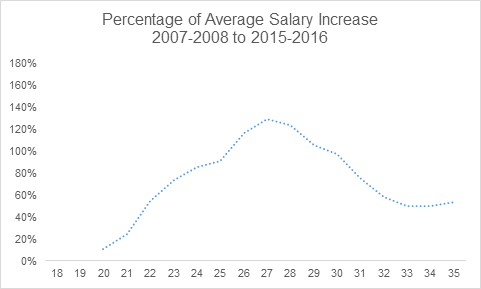Mar 1, 2016
Savvy sellers can exploit the NHL’s financial environment
Veteran players on team-friendly contracts can be turned into legitimate assets at the trade deadline, Travis Yost writes.
By Travis Yost

Yes, your first thought is correct – they were all traded at the deadline. And, collectively, for an impressive haul. The sellers of these respective assets received (including, but not limited to) three second-round picks, two fourth-round picks, and an assortment of prospects.
Talk to most of these teams, and the justification for the trades was more or less the same. They’re out of the playoff race, and the lottery tickets they received in exchange for these players – who, in most cases, were pure rentals for playoff teams – were of much more value.
Think, for a moment, of the teams who moved these players out. Excluding Montreal, every organization owning one of the above players entered the season with the idea that this year would be a rebuilding one.
So, why are rebuilding teams suddenly interested in signing or acquiring veteran players if the primary goal of the season isn’t to win a bunch of games?
It has an awful lot to do with the financial environment of the NHL, one that’s rapidly evolved in past years.
A second thing Stempniak, Winnik, Fleischmann, and Matthias have in common is that they were playing on ridiculously team-friendly contracts — both on dollar and term. Stempniak and Fleischmann both signed in the summer for one year and well under $1 million. Winnik signed this summer to a back-diving two-year, $4.5-million contract. Shawn Matthias also signed this summer, his deal of the one-year, $2.3 million variety.
There’s a good chunk of production across those four forwards even at the tail end of their careers, and all for very reasonable dollar amounts. Buyers at the trade deadlines recognized their worth, parting ways with a number of legitimate assets to acquire them for the stretch run.
The new financial environment –driven by increased financial restraint by teams during unrestricted free agency (perhaps at least partially generated by a lack of available resources to spend under the NHL’s hard cap) – offered opportunity for savvy, seller-type teams to swoop in and grab undervalued assets for the purposes of flipping down the road.
This is not mere coincidence. One of the biggest observable changes in the sport has been the increased time and expenditure devoted to younger players, and understandably so. But, by way of the limitations imposed by a hard salary cap, that’s had a detrimental effect on others – specifically, older players entering free agency and still looking for work.

This, to me, is fascinating. Remember that this is a league that operates explicitly against younger players by way of absurdly cheap entry-level contracts and constraints that bar young players from unrestricted free agency for years on end. There are a multitude of reasons for this, but the idea is that teams will generally float some of that money in the direction of veteran players. Or more accurately: veteran players who have been NHLPA constituents for a considerable length of time.
So, why the increase in percentage of total salaries in the 26-30 age group at the cost of the 31-35 age group? I think I have a pretty simple answer for that. More teams are willing to bet on younger restricted free agent players for longer periods of time. If the bet pays off, the team has a valuable asset on a team-friendly deal locked in long-term. It’s not without risk, but teams are growing progressively comfortable with wagering in this manner. I would assume it’s driven by the general shift towards younger labour.
I think that point is defensible, too. If we look at where average salaries are by age today versus where they were nine years ago, you can see where the biggest rises are. Hint: it’s in that window where players are reaching the end of their restricted contracts.

All ages have seen increases in salaries over the last nine years, and that’s because there’s just more money to spend per team. The cap alone has increased about $20 million in this timeframe. But again, the collective bargaining agreement has been extremely kind to that 24-28 age group. There are first-time unrestricted free agents (UFA) in that group, sure, but it’s mostly restricted free agents (RFA) trying to parlay a few years of experience into a mega payday.
And again, we see who loses out. It’s not the 18-21 age group, per se – they lose by way of the entry-level contract mechanism, but that’s a known league mechanism that hasn’t materially changed in forever. No, it’s the older players – a group comprised of first-time and second-time unrestricted free agents – who have seen their salaries stagnate relative to their younger peers.
Why is this important? Well, all of this is underpinning what we saw over the past nine months. Teams in seller mode from the October jump observed that the league had reached a point where at least a portion of these first and second-time UFAs were becoming undervalued. The value of being able to essentially sell one of these assets for extra draft picks (something you cannot buy in the marketplace) is obvious and does not need great detail to explain. And the financial risk had been mitigated by a palpable shift in how teams are spending their money these days.
There will never be zero risk associated with these transactions. The Leafs are a great example of how this sort of strategy can work out in some instances (Matthias, Winnik), and less so in others (P.A. Parenteau). But for a team whose primary goal is to acquire draft picks and build a Stanley Cup contender from the ground up, break-even on these deals is quite achievable.
Oh, and this isn’t going away anytime soon. There’s plenty of talk about next year’s impending cap disaster, with the possibility that the ceiling sits right around where it was during the 2015-2016 season. That would leave very little money to spend on UFA talent once the current contracts roll and all of the RFA contracts are signed.
And once again, the sellers will begin their work in September and October, preparing again for the trade deadline.

